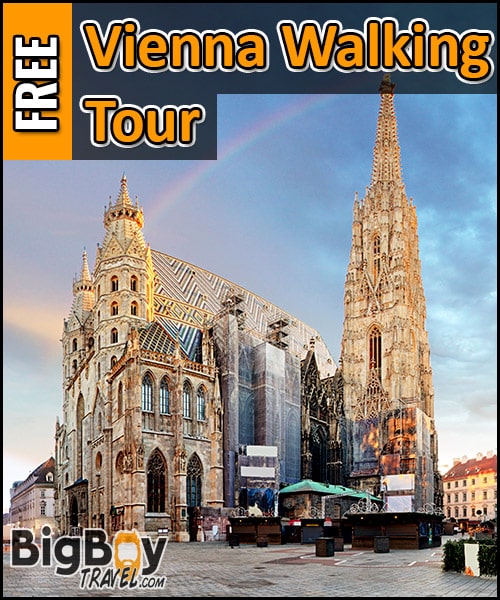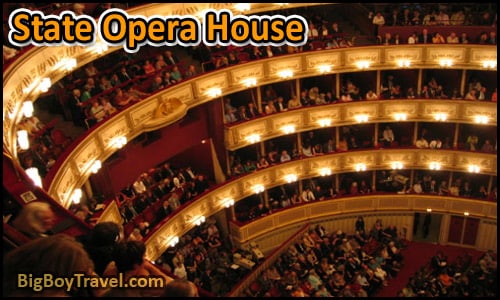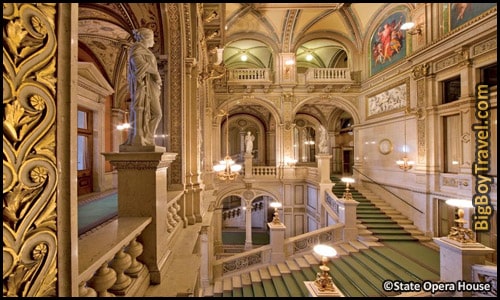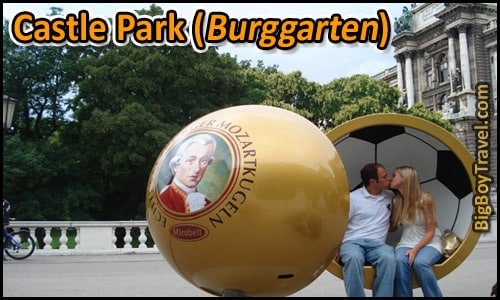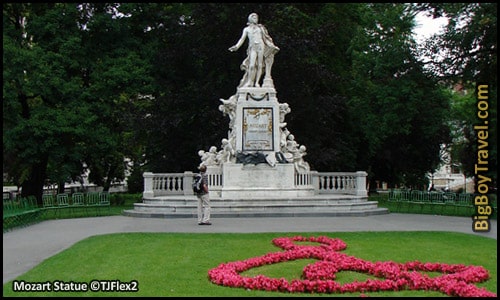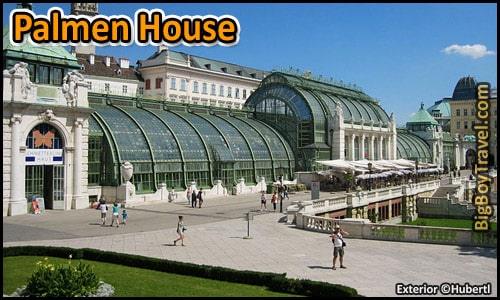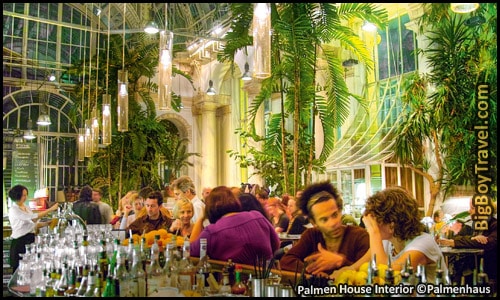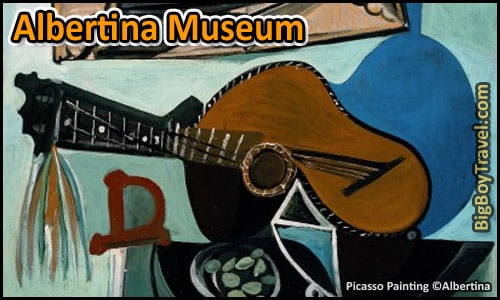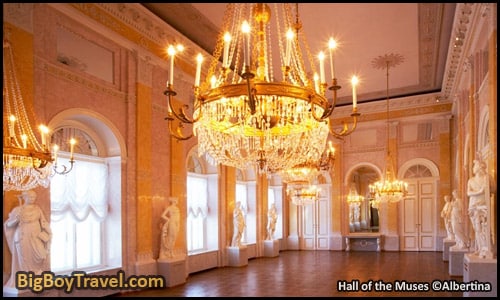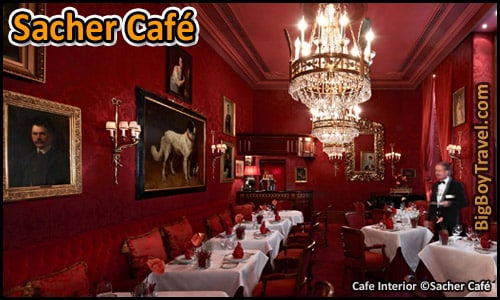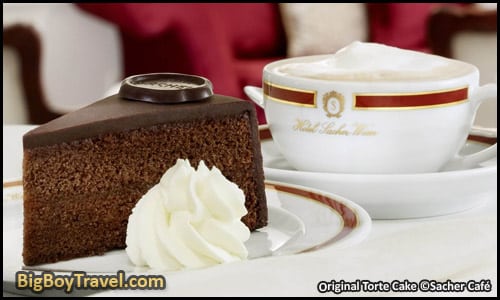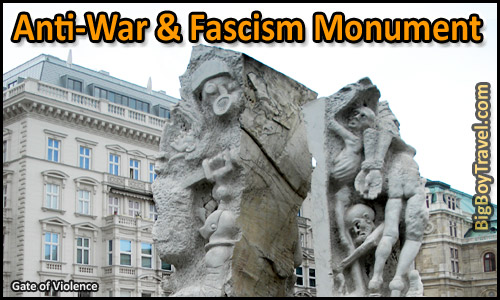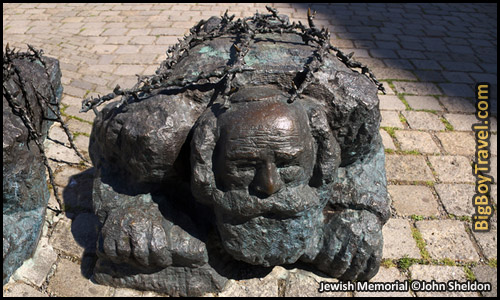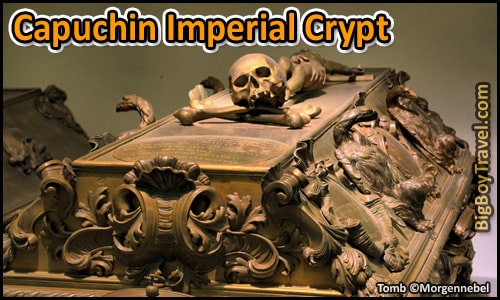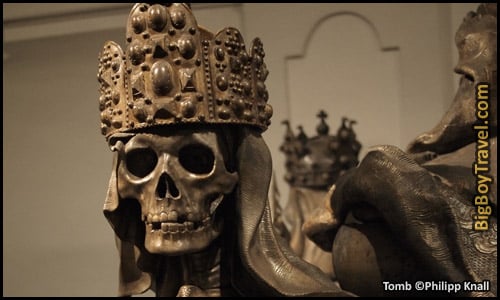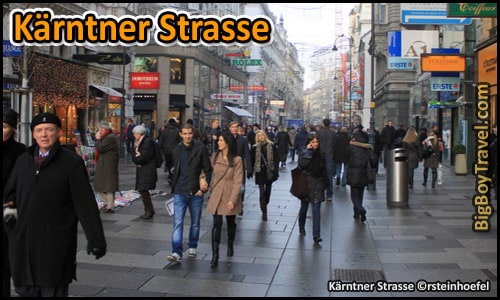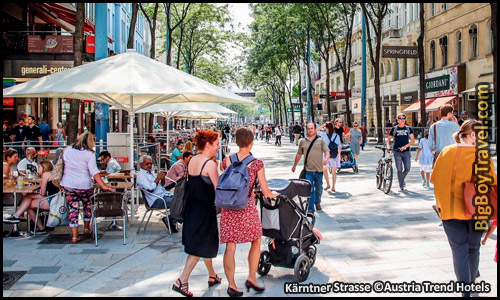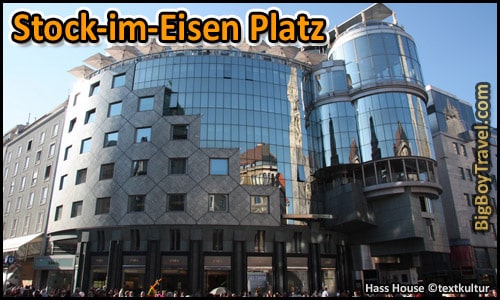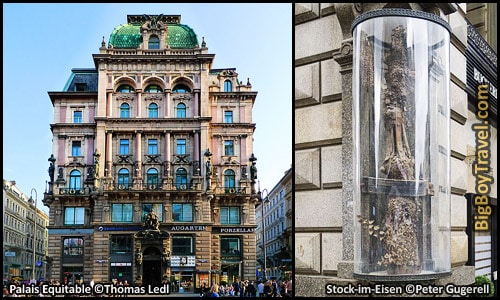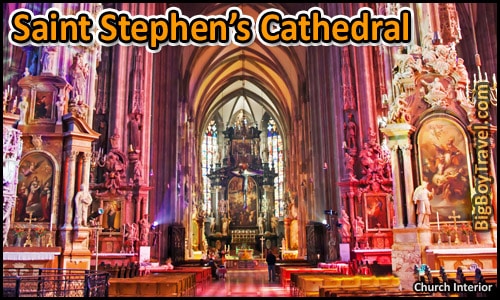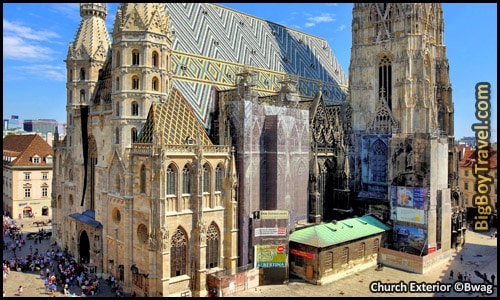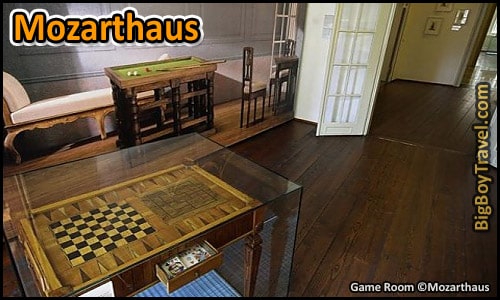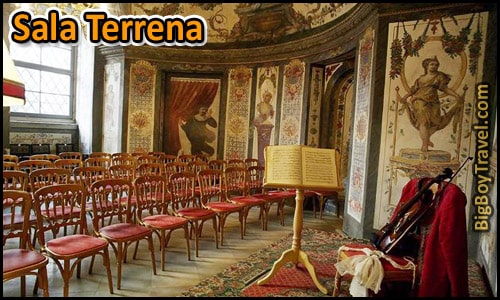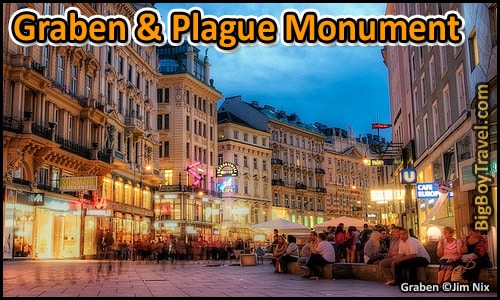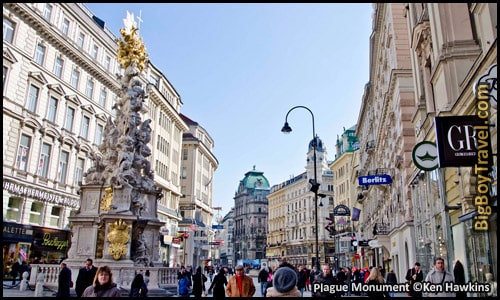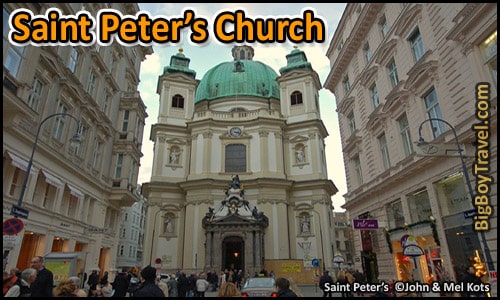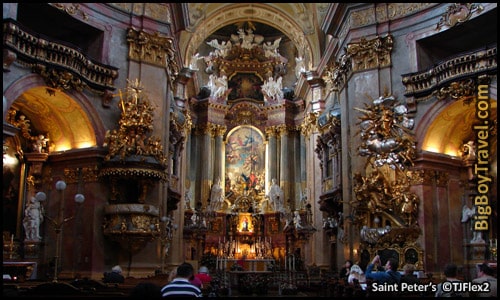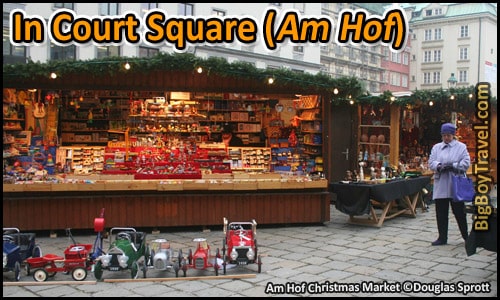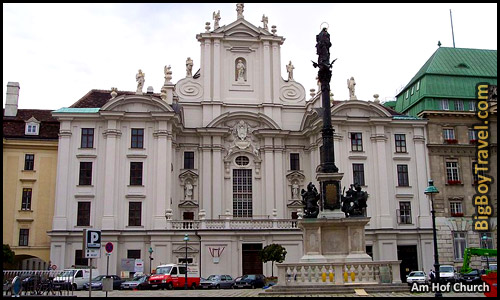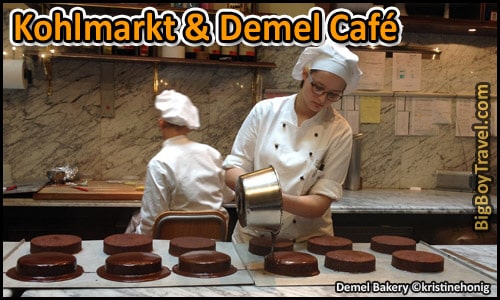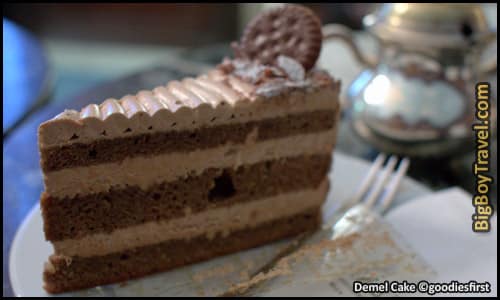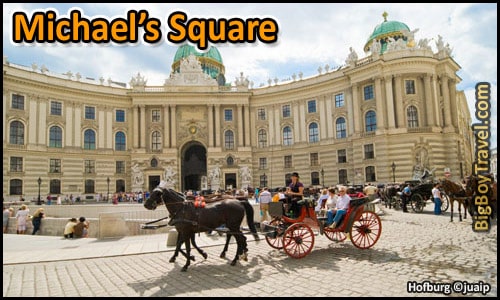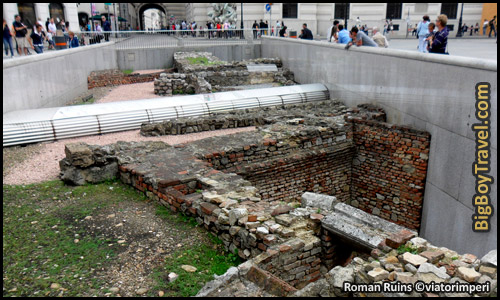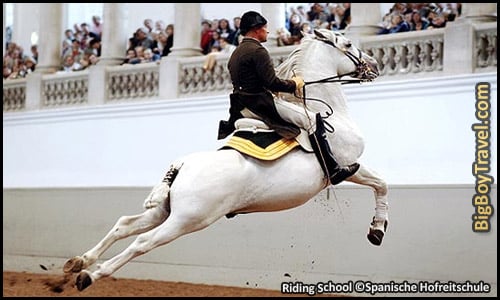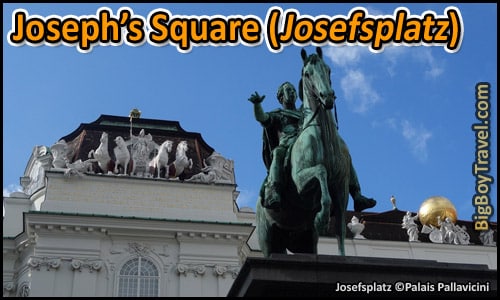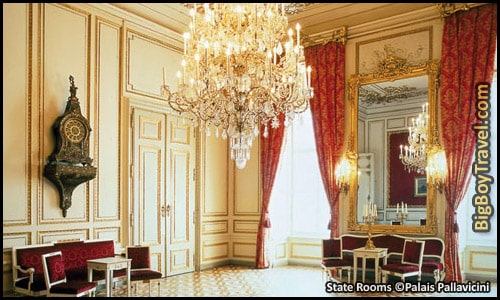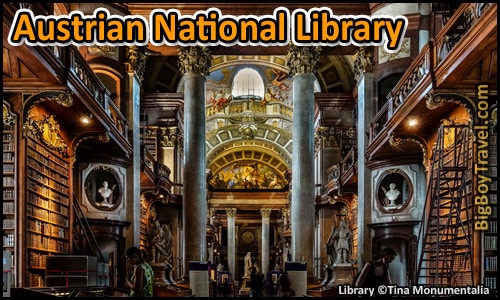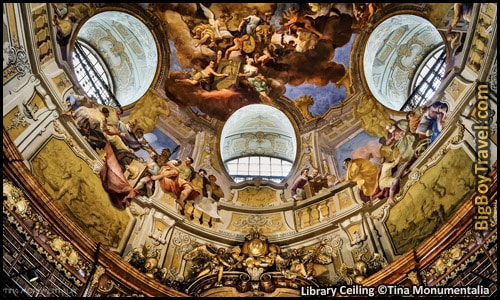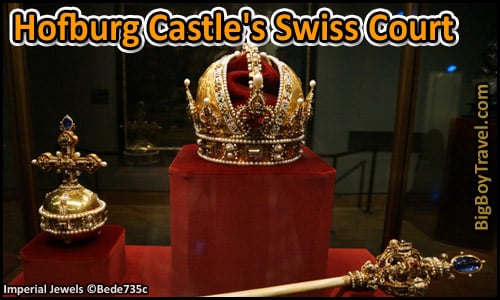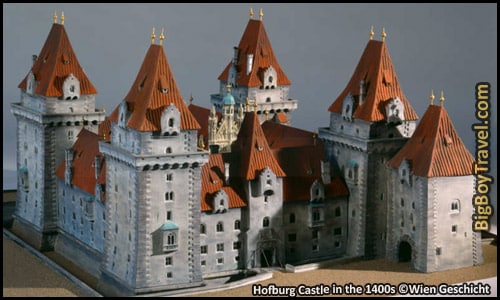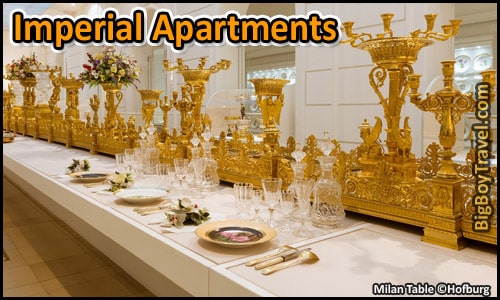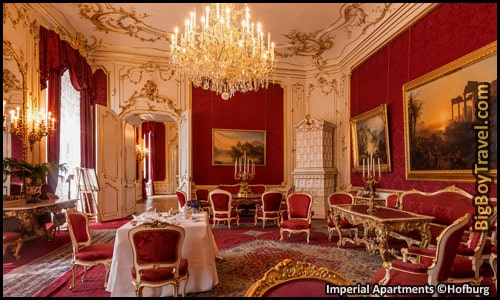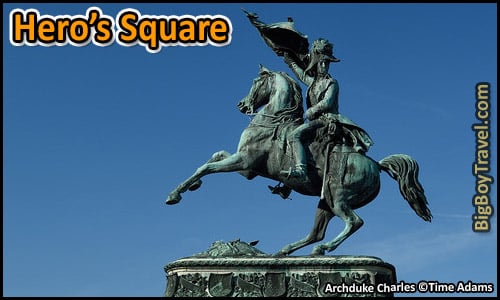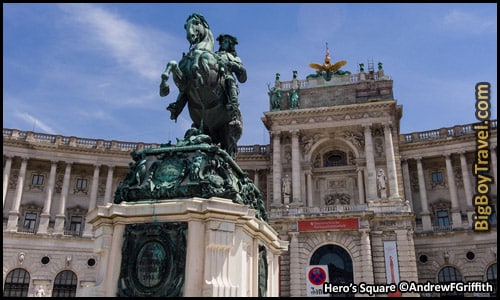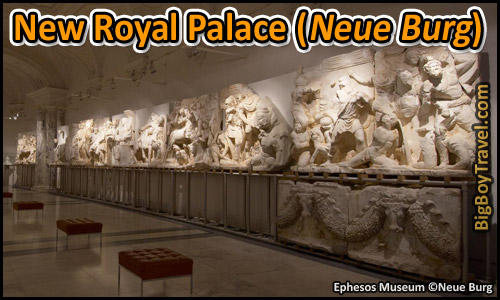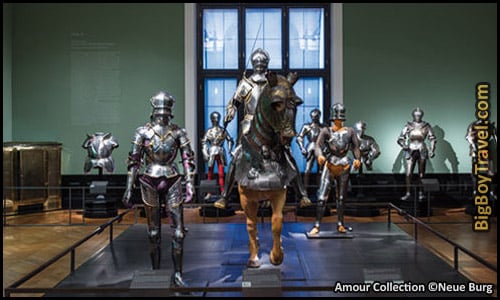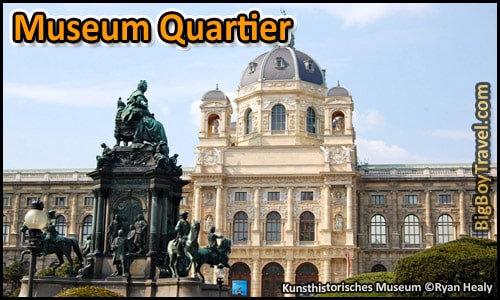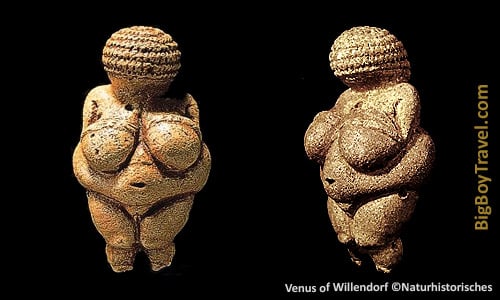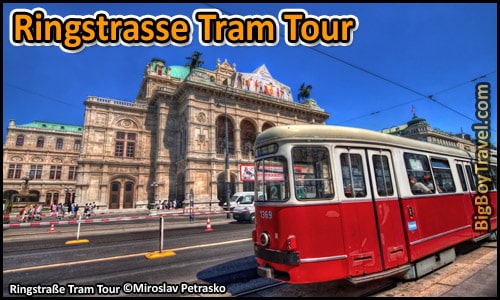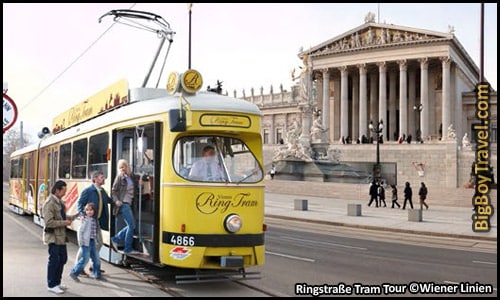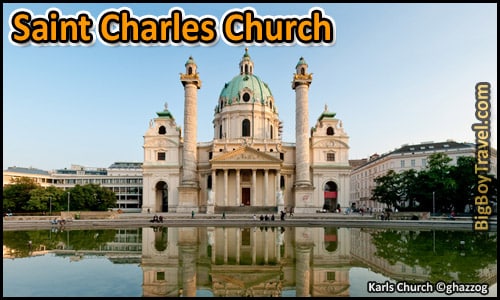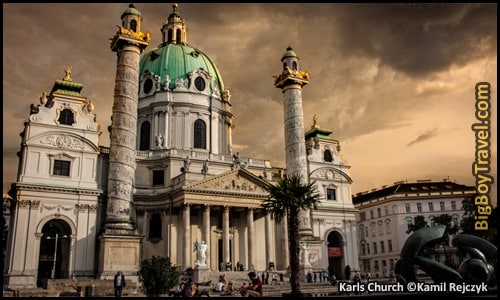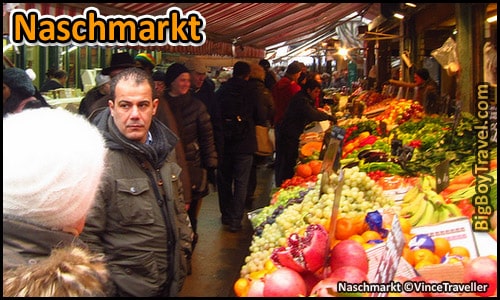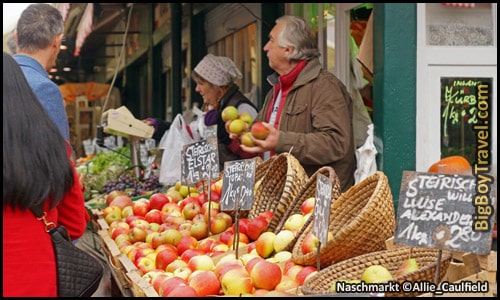Old Town Vienna Walking Tour:
Location: Vienna’s Historic City Center
Cost: Free, Self-Guided (Museum and sight costs below)
Style: Do-It-Yourself Walking Tour (Self Guided)
Start: State Opera House (Karlsplatz Metro stop)
End: Museum Quarter (Volkstheater Metro stop)
Walking Distance: 2.5 miles
Time: 90 minutes for walk (with sights 4-5 hours)
Fun Scale: 9.5 out of 10
The heart and soul of Vienna (Wien) is by far its beautiful Old Town which is filled with historic sights. Modern buildings mix in with tons of Medieval and Renaissance elements, making the city center quite magical. From cathedrals to beer gardens, and shopping to museums, there is diversity to entertain all travelers. Maybe the best thing about our free Vienna walking tour is that most of Old Town is very compact and easily seen on foot. Because the city center is so easy to walk, we created this free do-it-yourself Vienna walking tour map for you to follow which covers all the best stops with some insider tips. Enjoy our free Old Town Vienna walking tour!
History Of Old Town Vienna:
Settlement of Old Town Vienna began with Celtic tribes in 500BC with a riverfront camp called Castrum. The area grew thanks to the Romans who arrived in 15AD and built a walled military fort in 97AD to ward off Germanic forces. The Roman fort, called Vindobona (meaning White Village) took up about 1/3 the area of today’s Old Town. While mentioned in the movie Gladiator, Vindobona was where the real-life Emperor Marcus Aurelius died in 180AD. On this free Vienna walking tour, we will see some of the original Roman ruins, follow the outlines ancient camp’s wall, and give you a better understanding of early day Vienna.
At its peak, Vindobona had 6,000 legionary soldiers in its walled fort and 24,000 civilians in the surrounding suburban area, but was much smaller than the 50,000-person regional capital of Carnuntum. The Hun armies crossed the Volga River into Europe in 370AD and invaded as far west into the Roman region as Castra Constantias (modern-day Budapest). This broke down the Limes Road connecting the Roman camps along the Danube and the large regional capital of Carnuntum was sacked by Germanic tribes (Goths) in 395AD. By 433AD most of the Northen Roman Empire had fallen apart, the soldiers withdrew, the remaining citizens around Vindobona moved inside the walls of the abandoned camp.
The old Roman camp was refortified including a small castle Berghof Restsiedlung built in 800AD over the thermal baths to help defend against Magyar (Hungarian) armies. Shortly after, in 881, Vindobona took the name Vienna (Wein) after the Vienna River (Weinfluss) which is Celtic for Wood Creek. Under the rule of the Babenbergs and the Habsburg Dynasty (1153-1918), Vienna’s Old Town wall expanded outward and the city even became the seat of the Holy Roman Empire for over 300 years (1483–1806).
Vienna truly blossomed into one of the cultural hubs of Europe during the 18th & 19th centuries through the arts, classical music, and opera. The Waltz and Viennese Balls were born here and Vienna’s city center became home to musicians such as Mozart, Beethoven, Brahms, and Strauss.
Emperor Franz Joseph I and his wife Elizabeth (Sisi) made the biggest changes to modernize Vienna in the 1800s replacing the Medieval wall with the Ringstrasse Boulevard, fixing up nearby palaces, and tearing down homes in the Old Town to make way for new grand buildings. During this transformation, the Austrian Empire and Kingdom of Hungarian were merged and Vienna’s population quickly grew. While losing two World Wars greatly stunted city’s 200 years of booming progress, a modern second coming has made the historic Old Town Vienna a world class place to visit once again.
Free Vienna Walking Tour:
1. Vienna State Opera House (Staatsoper):
About The State Opera House: In a city famous for music and the arts, it is the grand Vienna State Opera House (Staatsoper), that definitely takes the prize. Opened in 1863, this gorgeous 1200 seat theater has housed some of Austria’s most famous classical musicians and still hosts over 300 performances a year. The beautiful theater and grand common areas make touring the Opera House amazing. If you are looking to catch a show, you can expect to choose from famous operas, ballets, and can even take part in large Viennese Balls each February.
This monument to music is the perfect place to start our free Vienna walking tour as the arts have been such an important part of the city’s culture and history. It was in Vienna where the Waltz was born and where Mozart wrote his famous opera The Marriage of Figaro. The building of the opera house was part of a larger protect in the mid-1800s where the Emperor replaced Vienna’s Medieval moated wall with grand buildings and a modern boulevard known as the Ringstrasse. Will will revisit the Ring Road at the end of this walking tour.
Guided Tours: 9€ for Adults; 4€ for kids; also includes the Opera Museum; 1-6 tours daily (check website). Tour is great and brings you to a lot of backstage areas. Live Performances: Tickets range from 16-215€, can be bought online, and go fast. Ticket Tip: If a show is sold out or if you just want a taste of a show without sitting through a 3-hour opera or ballet, they sell 567 standing room tickets the day of each performance, 160 of these tickets are right below the Emperor’s Box. Standing Room tickets are cheap, 2€ upstairs and 3.50€ downstairs, and allow you to easily leave when you’ve had your fill. These tickets go on sale 60 minutes before each show at the front door and 80 minutes before the show inside the side door at the Standing Room (Stehplätze) booth which always has a short line. Interactive 360 Degree Tour: (360 Degrees During a Viennese Ball). Opera House Website: (HERE).
2. Castle Park (Burggarten):
About Burggarten: Covering the entire backside of Hofburg Palace’s Neueburg wing is the large and peaceful Castle Park (Burggarten). From the 1200s through the 1500s, the Castle Park you see today part of a wide protective moat that circled Vienna’s Medieval city wall. It was these strong defenses that protected the city and stopped the Ottomans from taking over Europe in Siege of Vienna in 1529. After some further attacks in the mid-1600s, this Western section of the city wall was bumped outward to create a buffer zone for the nearby Hofburg Castle which also allowed the castle to gradually expand into a sprawling multi-wing palace.
By 1710, there was a vast private Royal park that started here and stretched a 1/2 mile to the Northwest along the inside of the expanded city wall. With the new found space in this huge Castle Park, the Habsburg rulers were able to build over their former private park, called the Paradise Royal Garden, to establish the Winter Riding School and National Library. We will visit both the riding school and library later on this free Vienna walking tour.
In 1806, Napoleon Bonaparte and his French forces heavily damaged the city wall and bastions near Castle Park before occupying the city, declaring an end to the Holy Roman Empire, and later marrying into the Habsburg family in 1810. A new curtain wall was added to repair the damage left by the French and Emperor Franz Joseph I got to work transforming this section of the park into a fenced-off private English Garden. During the park upgrades, around 1819-1820, Emperor Franz Joseph I had a statue of himself on a horse moved from the old Paradise Royal Garden to the pond in Castle Park. Cast in 1781, the statue is the oldest equestrian statue in Vienna and still a focal part of Castle Park.
Today the Castle Park has an awesome backdrop of the enormous Neueburg wing of Hofburg Palace (built from 1881-1913), which was we will visit later on this free Vienna walking tour. The new building divided the Royal park in two separating the English Garden which forms today’s park from the rest of the grounds.
Just five years of Neueburg was finished, the monarchy fell in 1918 and the private Castle Park became a public park almost overnight. More statues were brought into Castle Park from around Vienna after WW2 including one of Hercules originally cast in 1770. Our favorite piece that was brought in is the white-wash Mozart statue which was carved in 1896 and previously sat in nearby Albertina Square. Make sure to take time to relax in the park just like the Viennese royals used to do.
3. Palm Tree House (Palmenhaus):
About The Palm House: While revamping his private Castle Park in 1823, Emperor Franz Joseph I also had a huge two-winged greenhouse built on the Northeastern end of the royal garden dubbed the Palmen House. This gigantic greenhouse was built right over the foundation of a section of Vienna’s Medieval city wall that dated back to the year 1200. The Palmen House was a huge luxury for the royal family as it was able to grow tons of tropical plants and palm trees even in the coldest Austrian days.
In 1902, the Palmen House was expanded to over 22,000 square feet and remolded in its current Art Nouveau-style. In modern times, the Palmen House has been turned into a really unique restaurant where you can eat under the palms trees even in the dead of Winter. Especially if you have kids with you, consider stopping at the tropical Butterfly House (website) which is attached to the North side of the restaurant.
Palmen House Restaurant Hours: Monday-Friday 10am-Midnight; Saturday 9am-Midnight; Sunday 9am-11pm. The outdoor terrace bar is open until 2am in Summer. Restaurant Website: (here). Butterfly House Cost: Adults 7€; kids 4€.
3. Albertina Museum:
About The Albertina Museum: The Albertina Museum is a breath of fresh air house priceless art inside a stately villa. The most prized pieces are the works by Albrecht Dürer including the Young Hare from 1502 (original is displayed twice every 5 years, but an exact copy is shown daily). Other paintings & sketches include works by Monet, Picasso, Chagall, Klimt, Raphael, Warhol, and Rubens.
Like the Palmen House, the Albertina Museum was built over part of the early-Medieval wall section (called the Augustine Bastion) dating back to the 1200s. The property first served as the office for the Royal Court Building Authority before it was rebuilt as a mansion for Count Emanuel in 1744. This stately villa was later gifted to Duke Albert by Emperor Franz II in 1794. After moving in, the powerful Duke Albert started to display his private collection of works from old world master painters in the mansion which laid the groundwork for today’s museum. The works include the artists Da Vinci, Michelangelo, Dürer, Rembrandt, and Ruben.
Over the generations the Duke Albert’s family owned the villa, the back of it was expanded into parts of the neighboring Augustiner Monastery. The historic Augustiner Church was the only part of the block-long monastery complex (built in 1327) which was spared from the expansion of the Albertina Mansion. The church is famous as the location of many of the Habsburg imperial weddings including that Marie Louise to Napoleon Bonaparte in 1810. The Augustiner Church also holds the hearts of the former Hapsburg rulers.
The most famous of the 20 staterooms added onto the villa are the ones built for Maria Christina (1858-1929), the only one of Marie Antoinette’s siblings who was allowed to marry for love. The opulent rooms are typically called the Spanish Apartments because of Maria Christina’s marriage to the Spanish King Alfonso XIII. Her sister Marie Antoinette even stayed in the apartments before being sent off to France for her arranged marriage with King Louis XVI. Our favorite of the staterooms is the Hall Of Muses which is ringed with Greek statues and lit with 5 crystal chandeliers holding 258 candles.
Make sure to check out the wonderful bronze statue of Duke Albert on the terrace near the museum entrance. At the street level below the statue, there is also a magnificent fountain depicting the river God Danuvius and the embodiment of Vindobona, Vienna’s name in Roman times.
Museum Cost: 16€ for Adults; 19-26 years old 11€; Children under 19 are free; guided tour 4€. Online Tickets: To skip the line and get a mobile-friendly ticket you can book HERE. Museum Hours: Daily from 10am-6pm; until 9pm on Wednesdays & Fridays; best after Noon. Museum Website: (here).
4. Sacher Café:
About Sacher Café: Sacher Café is known for having the best slice of chocolate cake you can find anywhere. Their world-famous cake, known as the Original Sacher-Torte, was the creation of chef Franz Sacher who was asked to make a dessert for a Hapsburg royal party in 1832 while only 16 years old. Word of the Sacher’s amazing cake spread and he quickly became a household name.
Forever known as the family of rich cake, Sacher’s son Ed opened the Sacher Hotel and Café in 1876 and spared no expensive decorating every elegant detail. When Ed died 16 years later, his wife Anna took over and pushed the property to gain global recognition as one of the best hotels, all while continuing to sell the famous cake of course.
The Gürtler family has been running the Sacher Hotel and Café since 1934 and it remains one of the very few privately owned five-star luxury hotels in the World. The Sacher Café has been the meeting point for famous figures from Gandhi, and Queen Elizabeth II to John F Kennedy. A visit to Sacher is truly a must while in Vienna and even if you are on a budget just 8€ can get you a really good coffee and an excellent slice of cake.
Inside the Sacher Hotel, there are three different colored fancy salons for dining in addition to the main cafe plus the 2-story Eck which views over the Opera House. If there are crowds hoarding the fancier dining area of the cafe consider buying your Sacher cake at the neighboring Sacher Stube Café which is run by the same family. If you are confused and which coffee goes best with the cake, the traditional drink in Vienna is hot black coffee with foamed milk and whipped cream.
Hours: Daily 8am-Midnight. Photos: (Treat Photos via their Facebook Page). Restaurant Website: HERE. Cafe Website: HERE.
6. Anti-War & Fascism Monument:
About The Monument: In the late-1800s a huge luxury apartment complex named Philipphof was built right in the middle of this large open courtyard overlooking Albertina Square. Previously the courtyard had been a Medieval pig market before being turned into the apartments in 1882. During the construction, they found even more history when they dug up an ancient Roman grave and a 21-foot section of Roman road.
Sadly in the height of WW2, hundreds of residents sought shelter in the basement of the Philipphof Apartments and were buried alive in an air raid on March 12th, 1945. The bombing was so heavy that most of the victims’ bodies couldn’t even be recovered from the rubble. With the memory of the war victims in mind, a series of statues were erected in 1988 on the site of the former apartment which now serves as the Anti-War and Fascism Monument.
The Anti-War Monument is primarily made up of four artistic pieces which highlight the violence and tragedy that Austrians faced in WWII while under Nazi rule. The most predominant part of the monument are the two large carved marble columns called the Gate of Violence which represent the victims of war and the concentration camps. The graphic images on the columns are actually carved into stone that came from Austria’s Mauthausen Concentration Camp. Another heartfelt piece is the bronze figure kneeling and covered in barbed wired while scrubbing the street which is meant to be a reminder of the humiliation many Jews went through before being more formerly persecuted. There is also a memorial for the people who died in an air raid of the Philipphof Apartments and the final section celebrates a free Austria after the end of Nazi rule.
In 2009, the open square was renamed Helmut Zilk-Platz after the Mayor of Vienna who pushed for the monument to be built in the 1980s. The gravity of a visit is definitely is worth a moment of silence and reflection to take it all in. Knowing the history behind what you are looking at makes the Anti-War & Fascism Monument one of the most moving stops on our free Vienna walking tour.
7. Imperial Crypt (Kaisergruft):
About The Imperial Crypt: The unique and slightly creepy Imperial Crypt below the Capuchin Church is a true must-see on our free Vienna walking tour. The church was part of the Capuchin Monastery, founded in 1617 by the Holy Roman Emperor Matthias’ wife Anna. Just one year later Anna died followed by her husband in 1619 which lead the way for their nephew Ferdinand II to take over as Holy Roman Emperor. In honor of his family, Ferdinand II started work on a royal crypt below the Capuchin Monastery in 1622 which took 11 years to finish because of delays from the 30 Years War.
The tombs of Emperor Matthias and Empress Anna were the first to be moved in the Imperial Crypt which has since been expanded eight times to hold elaborate tombs of some of Austria’s greatest leaders. In total there are bodies of 150 members of the Hapsburg royal family buried at under the Capuchin Church. Oddly it is really only the bodies in the tombs as the Habsburgs’ organs are not buried here. The royal guts are actually housed below Saint Stephen’s Cathedral and their hearts are in the Augustiner Church. While the Crypt has huge visual and photogenic appeal, it is also a very informative experience. The most visited tombs are those of Empress Maria Theresa and Emperor Franz Joseph.
In front of the Capuchin Church is New Market Square which served as one of the main markets in Roman times when this area of town was a civilian settlement just outside the walls of the Vindobona fort. The square was given a makeover as the new city of Vienna was laid out in the 1200s and became it a grain market. The beautiful fountain from the 1700s is called the Fountain of Providence (Providentiabrunnen). This is a replica as the original fountain was moved from here to Belvedere Palace because the central statue had a bare-chested lady on it. Many of the buildings surrounding the square were leveled by bombing in WW2.
Crypt Cost: 7.50€ for Adults or 4.50€ for kids. Visiting Hours: Daily from 10am-6pm (last admission 5:30pm). Guide Tours: Wednesday-Saturday 2pm in German and 3:30pm in English for 3€ extra. Crypt Website: HERE.
8. Carinthia Road (Kärntner Strasse):
About Kärntner Strasse: Today the pedestrian-only Kärntner Strasse is one of Vienna’s most popular streets lined with great shops and places to eat. If you need to get any souvenirs for yourself or gifts while in Vienna then Kärntner Strasse is a perfect place to look. A stroll down the street offers excellent people watching, window shopping, and even your fix of American fast food, but we suggest sticking to the local cafes to get the true Viennese feel.
Back when Vienna was fortified military camp of Vindobona (97-433AD), Kärntner Strasse cut right through the 24,000-person urban settlement surrounding the fort. Initially called the Strata Carinthianorum, it cut straight South from the fort’s Eastern gate and past the main civilian market. The name Kärntner Strasse comes because the road led to Austria’s Southernmost state of Carinthia (Kärntner) which sits on the modern Alpine border with both Italy and Slovenia.
Kärntner Strasse became more important after the 50,000-person regional Roman capital of Carnuntum just 30 miles East of town fell in 395. This caused the North-South trade route called the Amber Road (Bernsteinstraße) to be re-routed from Carnuntum right down the center of Vindobona. The route which started in Saint Petersberg, Russia on the Baltic Sea and transferred precious amber to Rome, Greece, and even Egypt in the South with access later to the port of Venice.
While many of the Roman camps never recovered after the Northern part of the Empire collapsed by 433AD, Vindobona was reborn as Vienna (Wien) in 881AD. The re-foritifcation and re-settlement of the town was largely thanks to its river access and ability to sustain itself with trade routes like Kärntner Strasse.
The road finally got its own gate into the city when the old Roman walls were expanded outward in 1257 to make way for a growing Vienna. Through Medieval times, Kärntner Strasse even had a drawbridge and bastion over the city’s moat. Over the centuries, modern-day Kärntner Strasse was re-revamped along with the town and has remained one of the busiest shopping streets in Vienna.
8. Staff In Iron Square (Stock-im-Eisen Platz):
About Staff In Iron Square: As you reach the end of Kärntner Strasse, look immediately to your left and check out the Palais Equitable before getting distracted by any nearby sights. The humongous mansion was built for an American insurance company in 1891 in place of five Medieval buildings on what was once the small square called Staff In Iron Square (Stock-im-Eisen Platz). The square, which in ancient times was a Roman cemetery, was named after the historic nailing tree which sits encased in glass on the corner of the Palais Equitable.
The nailing tree (nagelbaum) grew nearby in the early 1400s and was used by travelers who pounded nails into it for good luck. The gesture was considered a sacrifice because in the Middle Ages iron nails were quite valuable. While the tree was cut down in 1440, the trunk continued to be used as a nailing tree, was put on display in 1548, and later iron banded by the former homeowner Hans Buettinger. As you inspect the Palais Equitable mansion, you’ll see reliefs on the doors showing the legend of the nailing tree.
In the 1900s, the North side of Staff In Iron Square was opened up to connect to Saint Stephen’s Square which we will visit next on this free Vienna walking tour. The focal point of this new construction is the very modern 8-story tall Haas House with flowing, curved glass walls. The building truly was meant to blend the old with the new as it sits right on the Southern corner of the former Roman camp Vindobona.
During the construction of the Haas House in 1990, it was very controversial that it was built anchored into some of the ancient Roman wall ruins. Make sure to get some photos of the Saint Stephen’s Church reflecting in the windows. If you are not too rushed and want the best view of Saint Stephen’s Church, head to the coffee house on the top floor of the Haas House for a unique perspective. The concept behind the design was to trace the Roman wall and provide a mirror image of Vienna’s largest church.
If you have an extra minute, make sure to go down into the subway station to see the underground Saint Virgil’s Chapel (Virgilkapelle) which was unearthed 40 feet below the ground in 1973. The old world chapel was carved out below the former Roman graveyard in 1220 as a private place for the Vienna’s wealthy residents to worship. Greek crosses, which can still be seen on the stone walls today were painted in 1246. In 1338 the funeral Chapel of Saint Mary Magdalene was built above the Saint Virgil’s which then became a bone house. A faint an outline of the former Saint Mary’s Chapel (burned down in 1782) can be seen in the pavement as you approach Saint Stephen’s Square.
10. Saint Stephen’s Church (Stephansdom):
About Saint Stephen’s Church: The massive Gothic-style Saint Stephen’s Cathedral is the focal point and geographic center that modern Vienna orbits around. Saint Stephen’s started as a small parish in 1137, in a large Roman cemetery in the former civilian area just outside of the walls of Vindobona. While Saint Stephen’s Chapel wasn’t finished until 1160, it was dedicated early in 1147 in the presence of King Otto II who was heading out to join the 2nd Crusade.
From 1230 to 1245, the chapel was completely redone as a larger Romanesque church with an impressive door and towers. Unfortunately, the Romanesque church burned down in 1258, but the front door and towers were saved and worked into the facade of the rebuilt church which was completed in 1263 over the ruins.
Looking at the front of Saint Peter’s today, you can still see the outline of the original Romanesque church towers. Working their way about halfway up today twin peaks you can see the change in the stone as they were extended upward in the rebuild and named the Roman Towers (Heidentürme). The 213-foot-tall towers got their name because they were built using pieces of the former wall of the heathen (heiden) Roman military camp called Vindobona. Keep in mind that during the time of the Roman settlement here, the Empire did turn Christian under Constantine so calling them heathen was more of the Medieval Duke’s way of appearing greater than their predecessors.
Saint Stephen’s finally got official Cathedral status shortly after the construction began on the Gothic-style Albertine Choir on the North end of the Church in 1359. The large choir, with three naves, has fantastic Medieval stain glass windows which are the only ones in the church to survive WW2. Instead of merely remodeling the rest of Saint Stephen’s original Romanesque interior to match the Gothic choir, they built a new church around it instead. New sidewalls were added outside of Saint Stephen’s, with a vaulted wooden roof hovering 125 over the floor. After the new walls and roof completely encapsulated Saint Stephen’s Church, the old side walls were simply removed.
By far the most iconic thing to come out of the Gothic-remodel is the mega-sized South Tower called Old Steve (Alter Steffl). At 466 feet tall, the gigantic tower dominates Old Town Vienna from every angle. We highly suggest taking the tiring 363 steps up to the top for the best views of Vienna. If you aren’t up for the hike up the Old Steve, consider taking the elevator up the North Tower (Nordturm) instead. The stumpy North Tower was supposed to be a complete match to Old Steve, but construction stopped in 1511 freezing it at 231 feet tall. While excavating for North Tower in 1443, they found a thighbone of a mastodon and placed it above the church’s front door nicknaming it the Giant’s Door (Riesentor).
The North Tower is best known for its large bell, appropriately named Boomer Bell (Pummerin), which famously rings each year at midnight on New Year’s Eve. The was cast out of Turkish cannons after the Siege of 1683, is over 20 tons in weight and 10 feet in diameter. It is considered the 2nd largest free-swinging bell in Europe. From either side tower, you will also get a great view of the brightly colored ceramic tiled roof which replaced the wooden one burn in WW2. The patterns on the roof include a double-headed eagle which is the crest of Vienna.
As you wander around Saint Stephen’s Cathedral there are a lot of exciting details worth noting. We really love the centrally located sandstone pulpit carved in 1510. It shows faces of the four fathers of the Latin Church (Ambrose, Jerome, Gregory and Augustine) as well as the artist who carved it peaking through a window near the stairs. Below the Medieval glass windows of the nave is the baroque New City Altar (Neustädter Altar) carved in 1447. Near the altar is the tomb of Emperor Frederick III who is one of the only Habsburgs to be buried outside of the Imperial Crypt. Below Saint Stephen’s Cathedral, you can tour the catacombs where the guts of the Habsburgs rulers are stored along with the bodies of Vienna’s cardinals and archbishops. The catacombs also have stacks of bones as bodies were tossed down here during a plague in the 1700s when the cemetery surrounding Saint Stephen’s Church was closed.
Around the Saint Stephen’s exterior, you can see the stark color difference where coal pollution darkened the church’s white limestone and where it has been cleaned. You will also see dozens of headstones from former church cemetery’s worked into the building’s facade. Speaking of death, Mozart had his funeral at Saint Stephen’s in 1791. The famous composer not only spent time working at the church, but was also married here in 1782.
Cathedral Hours: Monday-Saturday 9-11am & 1-4:30pm (restricted access starting at 6am); Sundays not until 1pm; Tower Climbs Daily 9am-5:30pm. Cost: Cathedral entrance is free but restricted unless you pay 6€ for the audio guide; North Tower 6€; South Tower 5€; Treasury 5.50€, Catacombs 6€ (takes 30 minutes). Discounted Online Tickets: You can skip the lines, save money, and get a mobile combo ticket for the South Tower, North Tower, Cathedral tour, Catacombs Tour, Treasury Tour, and audio guide HERE. Religious Service: Sundays & Holidays at 10:15am, 9:30am in July & August. Tower Access: South Tower via 363 steps or North Tower with elevator. Cathedral Website: (here).
11. Mozart’s Vienna Apartments (Mozarthaus):
About Mozart’s Apartments: Most of Mozart’s life was spent in his hometown of Salzburg, but he also had close ties to Vienna. It started when Empress Maria Teresa brought the young prodigy in to play a concert at Schönbrunn Palace as a child and continued when Mozart moved here in 1781 to get out from under the thumb of Salzburg’s archbishop.
Mozart was taken in by Vienna’s Archbishop Colloredo and lived his monastery for six weeks in the year 1781 from March 16th until May 2nd. The monastery was built in 1375 for the Teutonic Knights, and its intimate Sala Terrena concert hall where Mozart performed still hold live chamber music performance you can attend. Sala Terrena is Vienna’s oldest concert hall and was painted the Venetian late Renaissance style in the mid-1700s making it a fantastic place to hear a string quartet.
After leaving the monastery in 1781, Mozart moved in on the Graben near Saint Peter’s Square with the Weber who was in Vienna from Mannheim, Germany. Mozart had met the family in German in 1777 where he tried to court the daughter Aloisa, but ended up marrying their younger musician daughter Constanze in 1782 at Saint Stephan’s Cathedral. The couple moved around before settling on a lavish apartment behind the cathedral known today at the Mozarthaus Museum where they lived from 1784-1787.
The family’s apartment only had 4 main rooms, but with its city center location and rich details cost 450 florins a year to rent which was more than Mozarts dad’s annual salary. Although Mozart was horrible at saving money, he was making a lot of it teaching piano to young aristocrats mixed in with significant commission works. To the sculptured ceiling in the Camesina room. The Mozarthaus Museum is quite popular with theatergoers as the apartment is where Mozart wrote his famous opera The Marriage of Figaro which premiered in Vienna.
Most of the items on display at the Mozarthaus Museum today are from the time of Mozart and not actually his stuff, but it all helps to give a peek into his time here. Tours start on the 3rd floor of the building covering details of Mozart’s time in Vienna. The displays focus on where Mozart lived and performed, who his friends and supporters were, his relationship to the Freemasons, his passion for games and much more. The presentation on the 2nd-floor deals with Mozart’s operatic famous works he wrote while living here, and the apartment on the 1st floor focuses more on Mozart and his family. The basement also has a vaulted ceiling event space that often holds piano concerts.
Mozarthaus Cost: 11€ for Adults, 4.5€ for Children, also has a family rate of 24€ (up to 2 Adults, 3 kids). Discounted Tickets: You can save money and get a free audio guide by pre-booking HERE. Mozarthaus Hours: Daily from 10am-7pm; last entrance 6:30pm; least crowded 10am-Noon. Mozarthaus Website: (here). Sala Terrena Concerts: 90-minute concerts are on Thurs, Fri, & Sun at 7:30pm and Sat at 6pm. Sala Terrena Website: (here).
12. Graben & Plague Monument (Pestsäule):
About The Graben: The Graben (meaning ditch), was once used as a dry moat by the Romans along the Southern wall of their ancient military camp Vindobona (97-433AD) which pre-dates Vienna. With Vienna’s population growing the graben was filled in and the walls were expanded outward in the 1200s. A King’s ransom largely funded this massive project, and it’s from a tail you may have heard of before.
After fighting together in the 3rd Crusade, Duke Leopold V of Austria captured King Richard I of England (also known as Lionheart) over a dispute. King Richard (of Robin Hood fame) was held as a prisoner for 14 months from 1192-1194 while his brother Prince John sat on the throne. It’s said that Pince John offered to pay the Duke to keep his brother longer so he could stay on the throne. King Richard, I was finally released after a colossal ransom to the Holy Roman Emperor, of which Austria got 35 metric tons of silver (worth over $15 million today).
For the next 60 years, this ransom money was used on projects in Vienna from establishing the Austrian Mint, filling the Graben, building churches, and expanding the city wall. With the wall expansion completed by 1257, the Graben quickly became a market and busy shopping street. The first of two elegant fountains along the Graben is dedicated to Duke Leopold V for getting the money to start the project.
The half-timber Medieval homes first lined the boulevard are now gone, can see the wealth the shopping has generated by the elegant facades of massive buildings that line the Graben. We love walking here as the Graben became Vienna’s first pedestrian-only area in 1974 and it feels built for people watching. If you happen to be in Vienna during Advent (late-November through Christmas), you need to put a night-time stop at the Graben on the top of your list as its endless strings of holiday lighting are magical.
Americans visitors often overlook the impact of the epidemics in Europe during the Middle Ages making the Plague Monument (Pestsäule) in the center of the Graben an important attraction. The 69-foot-tall column was built in 1693 to honor the 1/3 of Vienna’s population who died in the Plague of 1679 and pays thanks to God for the ones who survived. The golden-capped Baroque column replaced a previous column dedicated to the Holy Brotherhood. It was the Brotherhood of the Holy Trinity who was among the first groups in Europe to use science to stem the plague in a time where religion and superstition trumped all.
Photos: (Night Time During Advent).
13. Saint Peter’s Church (Peterkirche):
About Saint Peter’s Church: As you turn the corner off the Graben down Jungferngässchen Alley you catch your first glimpse of the green-domed Saint Peter’s Church. Entering the alley, you are also crossing what was once the Southern wall of the Roman fort Vindobona (97-433AD). Local folklore says a larger Romanesque-style church was built here by Emperor Charlemagne between 792-800AD while the former camp was being re-fortified.
While Charlemagne church story may be true, records show that the first church here named Saint Peter’s was finished in 1137 before the original city walls were expanded outward. The church which was later run by the Scottish Monastery which burned down in the late-1600s giving way to the Baroque masterpiece you see today.
Completed in 1732, today’s Saint Peter’s Church is one of the hidden gems on this free Vienna walking tour. We are amazed the builders were able to fit such a large structure tightly tucked into a small square. When you get inside the church, you quickly forget how small the plot of land is that it sits on. This is because the builders used an open layout and unique dome to make Saint Peter’s Church feel huge. Unlike most churches, Saint Peter’s is actually oval shaped instead of round to take maximizing the space to a whole new level.
Most people walk by taking a couple of pictures of the exterior and leave, don’t be one of those people. Take a couple of minutes to step inside, inspect the beautiful marble interior, and see if you can make out the dome’s oval shape.
Hours: Monday-Friday 7am-8pm; Weekends 9am-9pm. Cost: Free. Tours: Daily 9-10am & 1-3pm. Interactive 360 Degree Tour: (Interior). Church Website: (here).
14. Vindobona & In Court Square (Am Hof):
About Vindobona & Am Hof: Lightly settled by the Celts in 500BC, the groundwork for modern-day Vienna was laid out from 15-97AD as a fortified Roman camp named Vindobona (meaning White Village). Outlined on our free Vienna walking tour map, the walled Vindobona fort marked the edge of the Roman Empire at the time and was used to help fight off Germanic forces North of the Danube River.
While the nearby regional Roman capital of Carnuntum was much more significant with over 50,000 residents, at its peak Vindobona was home to 6,000 soldiers inside its walls and another 24,000 residence in the surrounding urban area. The most famous moment in the history of the camp was when Roman Emperor Marcus Aurelius died here in 180AD. After the Northen Roman Empire fell in 433AD, the remaining citizens around Vindobona moved inside the walls of the abandoned camp, and the population drastically declined.
The former camp was re-fortified in the 800s including a small Berghof Restsiedlung Castle to help defend against Magyar (Hungarian) armies. The castle was built over the Roman thermal baths between the Hoyer Market and Saint Ruperts Church. Shortly after the refortification, Vindobona took the name Vienna (Wein) in 881 after the Vienna River (Weinfluss) which is Celtic for Wood Creek.
In 1156, Heinrich II of Babenberg was forced by the Holy Roman Emperor to give up his title Duke of Bavaria to Henry the Lion and was named the 1st Duke of Austria by the in return. With a fresh canvass at his disposal, Heinrich II moved to Vienna and built Castle Babenbergerpfalz inside the old Roman wall. The new castle sat right on the foundations of Vindobona’s former barracks and armory in the former fort’s Southwest corner (where today’s Am Hof Church and Park Hyatt Hotel are). The large square next to the castle became the city’s 1st established Royal Court (Am Hof). So if you stay in the Park Hyatt (website) today, you are not only staying at one of the best hotels in town, but also over the former castle.
The Duke really wanted to impress his wife Theodora Comnena, who was a Byzantine princess, with is new city plans. He used is former home, and capital of Bavaria at the time, Regensburg, Germany as the model to layout Vienna. Under Heinrich II’s rule, Vienna quickly became the 2nd largest city in the Holy Roman Empire behind Cologne, Germany.
Five years after the last Duke in the Babenberg family died in 1246, Ottokar Duke of Moravia (King of Bohemia) was elected Duke of Austria and significantly expanded the Kingdom to stretch all the way to the Adriatic Sea. Ottokar also started to expanded Vienna’s city walls outward and built a new four-towered royal castle called Hofburg on the Southern edge of town (see photo).
In 1273, Rudolf I of Hapsburg (King of Germany) was elected the new Duke of Austria, but Ottokar wouldn’t give up his title which led to his death on the battlefield. Rudolf’s success led to 645 years of Hapsburg rule over Austria including over 300 years as Holy Roman Emperors (1483–1806). While the royal court was officially moved to Hofburg Castle, Am Hof Square at Castle Babenbergerpfalz continued to be used for jousting tournaments and a market.
While most of the old Castle Babenbergerpfalz was removed, part was rebuilt as the Gothic-style Am Hof Church in 1386. The church was given its current white Baroque facade in 1662, and the Mariensaeule (Marian Column) was added to the center of the square. The column, finished in 1667, was commissioned by the Holy Roman Emperor Ferdinand III to thank the Virgin Mary for repelling the Swedish forces during the 30 Years’ War. In 1806, having defeated the Austrian army, Napoleon announced the end of the Holy Roman Empire from the balcony of the Am Hof Church. This move split the former territories up and established the Austrian Empire.
Am Hof Square got a rise in pop culture thanks to the hit 1949 movie The 3rd Man. Many scenes from the famous film take place here from Anna’s door to Orson Welles’ character Harry Lime casting a long shadow in the alleyway North of the Church. In the cellar of the Am Hof Square’s Fire Brigade Building, you can still find the remains of a main brick drain from the ancient Roman sewer system beneath Vienna.
For more Vindobona sites check out the Roman Museum (website) under Hoyer Market. Located on one of Vienna’s oldest market squares, the museum has a great collection of authentic Roman era artifacts. The best objects are the intact sections of soldier homes and underground heating they found below the square. We also like stopping Saint Rupert’s Church which is Vienna’s oldest church dating back to 740 and sits near a maze of Medieval streets.
15. Kohlmarkt & Demel Café:
About Kohlmarkt: The prestigious Coal Market (Kohlmarkt) shopping lane is home to Vienna’s most luxurious stores. From Tiffany’s to Gucci and Louis Vuitton you’ll find a little bit of everything for today’s high-end buyers. In Roman times, this road led to the main Southern gate tower (Peilertor) of the walled fort called Vindobona (97-433AD) which pre-dates Vienna. It was an important road as two blocks outside the walls it intersected with a civilian bypass of the Lime Road (Limesstrasse) trade route around the fort before continuing all the way through Linz to Salzburg (then called Juvavum).
When the Roman wall was extended outward in 1257, the lane remained vital as it connected the new Royal Castle (Hofburg) to the heart of Vienna. While the name Coal Market came from the coal dealers who once set up shop here, it quickly became a prestigious shopping area. Kohlmarkt was soon home to the shops of various jewelers appointed by the Royal Family and gained the nickname the Golden U.
During the 1700s, the street blossomed into a well-rounded, high-end shopping street. Even the original city gate tower, called the Direction Finder Tower (Peilertor), also remained an essential feature of Kohlmarkt. Through Medieval times the tower (rebuilt in 1511) served as a watchtower and jail until it was removed for traffic concerns in 1867.
Today the lane is a real treat, especially during Advent when hanging lights give Kohlmarkt a beautifully lit temporary ceiling. While you window shop along Kohlmarkt, the one place you have to make sure to stop at is the Demel Café & Bakery. Dessert artist and baker Ludwig Dehne moved to Vienna from Wuerttemberg in 1786 and quickly impressed the Emperor with his skills. In the bakery’s early days, all the ladies of importance in Vienna came to the cafe to drink a cup of hot chocolate on the first cold day of the year.
Ludwig’s cafe business did so well that it gained the esteemed prefix K. u. K., or König und Kaiser, meaning “good enough for the king”. With Vienna being a trend-setting cafe town, Ludwig’s bakery became a favorite meeting point of the aristocracy as well as of the bourgeoisie. In 1857, Ludwig son August sold the shop to his first assistant Christoph Demel giving the cafe its current name. Even though it is a fancy place, Demel offers a 10€ cake and coffee deal, along with their other amazing chocolates and desserts to make your mouth water.
Demel Hours: Daily 9am-7pm. Demel Website: (here).
16. Michael’s Square (Michaelerplatz):
About Michael’s Square: Michael’s Square is dominated by the Baroque facade of Hofburg Palace’s Saint Michael Wing. This huge building was completed in 1889 in place of the old Royal Theater (Burgtheater). The former theater had opened here in 1741 inside an unused Royal banquet hall and was where many famous musical premieres took place. These premieres included Mozart’s Marriage of Figaro in 1786 and Beethoven’s 1st Symphony in 1800. While the first sections of the Royal Castle (Hofburg) were built near the Square in the mid-1200s, it’s been a critical intersection for nearly 2,000 years.
In Roman times, a civilian bypass of the Limes Road (Norica Limes) around the legion fort Vindobona (early day Vienna) met the main road into the fort’s Southern gate at Michael’s Square. The intersection also connected to a secondary route to Linz and Salzburg, but the diagonal bypass off the Limes Road (seen as Herrengasse Street on modern maps) was the big driver of traffic. The Limes Road essentially marked the Northern border of the Roman Empire while linking the 30 main legion camps along the Rhine and Danube Rivers from the North Sea all the way to the Black Sea.
At the crossroads of Michael’s Square stood a large guarded Roman Legion outpost (Canabae Legionis) to help protect the South side of the fort, its 6000 soldiers, and the 24,000 area civilians who lived outside of Vindobona’s walls. Eventually, the Limes Road broke down from hostile invasions (Huns & Germanic Goths) and most of the Northern Roman Empire collapsed by 433AD. Vindobona was largely abandoned until it was re-fortified as Vienna in 881AD, but luckily remains from its Roman roots are still easily found.
Ruins of the Roman Legion outpost at Michael’s Square were excavated in 1990, unearthing an entire neighborhood of Roman building foundations and ancient sewers. In addition to the guard houses, the outpost buildings were believed to have included shops, an inn guesthouse, and a brothel. Further excavations around Michaelerplatz have shown that the Romans also had created a long aqueduct to get water from the surrounding hills as well as several canals dug all the way to the Danube River.
The Roman Legion outpost was essentially like a small suburb, although it wasn’t given a town charter. The civilian settlement spread out many blocks from Michael’s Square and foundations of half-timber homes have been found in the courtyard of the Globe Museum (Herrengasse #9), Porcia Mansion (Herrengasse #9), and the Harrach Mansion (Freyung #3). You can see the extent of the civilian settlement centered on Michael’s Square to the South of the square Vindobona fort here.
Before leaving the square, make sure to check out Saint Micheal’s Church which it is named after. First completed as a small Romanesque chapel from 1221-1252, it was rebuilt in 1792 as you see it today. The church is best known for its captivating crypt with the bodies of 4,000 wealthy residents who are buried here with many of them mummified or with open caskets. The crypt is very interesting, but is one of the most overlooked tourist spots on this free Vienna walking tour. Investigating the open ruins and sights around Michael’s Square is one of the best windows into Vienna’s Roman past.
17. Spanish Winter Riding School:
About Spanish Winter Riding School: The Spanish Riding School has been operating in Vienna since 1565 when it was a wooden stable in nearby Josefsplatz Square making it the oldest riding school in the World. The beautiful Spanish Winter Riding School building you see today was built into Hofburg Palace in 1735 in place of the former Paradise Garden.
This historic riding school gets its name from the stars of the show, the delightful white Lipizzaner horses from Spain. Getting accepted into the Spanish Riding School has always been a very prestigious thing. In its early days, the riding school was limited to young aristocrats and royals who used it to practice jousting and horse dancing called dressage. The horse dance training helped the riders the gain agility and control needed military campaigns. Outside of occasional public festivals, watching the horse dancing practices were reserved for the Royal family and guests of the court until the monarchy fell in 1918 which opened the shows up to the public.
Tickets for the horse dancing shows can be hard to come by so make sure to book ahead if possible. Even if you can’t make a dressage show, consider one of the school’s architectural tours that brings you through every nook and cranny of the building including the rafters. In addition to the horse ballet shows, the training space also hosts a series of elegant Viennese Balls throughout the year.
Across the street from the Winter Riding School is the Renaissance-style Royal Horse Stables (Stallburg). The stables were first built from 1559 to 1569 as a mansion for crown prince Maximilian II by his dad Emperor Ferdinand I. Folklore says that the Emperor wanted his son under a different roof as they had differing religious views. The mansion later housed part of the royal art collection which helped to launch Vienna’s Art History Museum. When the new Winter Riding School opened in 1735, the mansion was turned into the official Royal Horse Stables and is now an active museum.
Ticket Office Hours: Tuesday-Sunday 9am-4pm; on Fridays when there is a performance they are open until 7pm. Morning Exercise: Most weeks Tuesday-Friday from 10am-Noon you can watch Morning practice to music for 15€ which is lighter on the jumping. Check the schedule here as some months have training every day. You book at the box office each morning. Main Performances: The full dressage show performances typically happen on Saturday and Sundays at 11am and can sell out far in advance. Standing tickets room start out at 25€ and go up to 135€ for the lower level seats. You can book online here or at the box office. Please note that from late-June through early-August they typically don’t run the full show, but will have practice. Guided Tours: Most afternoons they have 2-5 time slots for 50-minute guided tours of the grounds and stable for 18€ (kids half off) with the most time slots on Mondays while the horse training is off. You can book at the box office each morning. Riding School Website: (Here).
18. Joseph’s Square (Josefsplatz):
About Joseph’s Square: Before checking out the beautiful National Library, it is essential to inspect the often overlooked Joseph Square (Josefzplatz). Today the main feature of the square is the giant equestrian statue from 1795 of Emperor Joseph II in Roman clothing riding a horse.
The equestrian statue is actually a take on an ancient statue of Roman Empire Marcus Aurelius which sits on Capitoline Hill in Rome, Italy. The connection is important both because Marcus Aurelius died in the Roman camp Vindonba (early day Vienna) in 180 AD and the Habsburgs always claimed to have a bloodline connection to the Roman leaders. This equestrian statue is also fitting as Joseph Square was once the home to the original Spanish Riding School back when it was just a small wooden structure.
As you circle the square, there are a couple of old mansions that are worth mentioning. The 1st is the beautiful Pálffy Mansion (website) which served as a law office in the 1300s, was rebuilt as the home of a banker in the 1600s, and given a new facade after damage from WW2. Mozart performed at Pálffy Mansion as a child and did screenings of this opera The Marriage of Figaro with a small audience before premiering it at the Royal Theater that once sat a block away at Michaelplatz. Every night at 8pm (except Wednesdays) you can get tickets for the Vienna Walzer Orchestra which performs for small crowds just like Mozart once did here.
Next door to Pálffy Mansion is the impressive Pallavicini Mansion (website) which was once the site of the Queens Monastery (1581-1782). Unlike Palffy, this mansion was largely untouched by WW2 and serves as a time capsule for Viennese life in the late 1840s.
On the South side of the Joseph’s Square is the former Augustiner Monastery Complex (built in 1327), which still has some of its original inner courtyards and main chapel. The monks had been operating in Vienna since 1260, and Pope John XXII directly approved the building of this complex. The small Loreto Chapel next to the main altar holds the hearts of various Habsburg rulers. Earlier in this Vienna walking tour, we saw the royal bodies in the Imperial Crypt and their guts in Saint Stephen’s Cathedral. The church probably the most famous as the place of many Habsburg imperial weddings including that of Marie Louise to Napoleon Bonaparte in 1810.
19. Austrian National Library:
About The Austrian National Library: Built by Emperor Charles and Empress Maria Theresa from 1720-23, the Austrian National Library remains one of the most beautiful libraries in the world to this day. It is easy to find the entrance as the building is capped by a large golden globe supported by a statue of the Greek God Atlas. A walk through the Baroque State Hall is bound to leave any visitor with a sense of wonder.
The library’s marble accents are fantastic and the ceiling paintings are among some of the best for any building of its era. The paintings are so detailed that it’s no wonder they took an extra 7 years to complete after the library was open. The scenes show the virtues of the Hapsburg rulers as well as depictions of their territories.
The Habsburg Dynasty was a dominant one who had already had a private library collection started as early as the 1300s. This meant that the new library was able to be filled with over 400 years of treasures the day it opened. Mix in an over 300-year span where the Hapsburgs served as Holy Roman Emperors (1483–1806), you have the makings of one of the best book collections in the world. Construction plans even had to be expanded mid-build in the 1700s as the family’s collection continued to grow.
Two of the most popular exhibits run by the library are the impressive Papyrus and Globe Museums. The Papyrus Museum is best accessed through the reading rooms entrance of Heldenplatz (Stop 21) while the Globe Museum is just down the street (Herrengasse Avenue #9).
Library Hours: Daily 10am-6pm; Open Thursdays until 9pm. Cost: 7€ for State Hall; Add for 4€ the Papyrus and Globe Museums; Discounts for kid & families. Audio guide 5€ for 2 people. Library Website: Here.
20. Hofburg Castle’s Swiss Court (Schweizerhof):
About The Swiss Court: This was the original portion of today’s Hofburg Palace (or Imperial Castle), built from 1220 to 1278 as a square Gothic castle with corner towers. The most construction happened along the expanded city walls under Ottokar II who became the Duke of Austria in 1251 and also soon became the King of Bohemia (1253-1278). After failing to win the Imperial crown numerous times and raising arms about it, Ottokar II was crushed in battle in 1278 and his castle was taken by the Habsburg who ruled Austria for the next 750 years (1278-1918).
Only fragments of the original castle remain today as it was given a Renaissance makeover in the 1400s. This project included a complete rebuild of the Palace Chapel (Burgkapelle) in 1449. A beautiful wooden statue of the Virgin Mary near the altar was carved in 1410 and is quite stunning. The royal chapel was first established in 1296 (remodeled again in the 1700s) and is famous for the angelic Vienna Boys Choir (website) who have been signing High Mass since 1498. They are one tour in July & August so if you miss out on the Boys Choir, the nearby Augustiner Church (built in 1327) also has music at their 11am religious services.
In 1745, the original castle got another facelift during an expansion of the Palace, and the central courtyard was renamed the Swiss Court (Schweizerhof) after the guards who protected the Royal family. This substantial makeover also saw the removal of the corner towers and the castle’s drawbridge which once led to the preserved red-black Swiss Gate (Schweizertor) from 1552. The impressive gate displays the Holy Roman Empire’s Imperial Coat of Arms in the variation of the Order of the Golden Fleece which is a secret Medieval fraternity established in 1430. On the ceiling inside the Swiss Gate are murals showing the titles and lands ruled by Emperor Ferdinand I.
The core of the former castle now houses the Royal Treasury in over 21 Medieval rooms. While touring the Treasury, you will see the jewels of the Holy Roman Empire, including the Imperial Crown and the Holy Lance, the Crown of Emperor Rudolf II, and gems including one of the world’s largest emeralds. You will also see a ton of Holy Relics in the Treasury as the Habsburgs had become obsessed with collecting them as a status symbol. There are items from the Order of the Golden Fleece, and Counter-reformation among other secular treasures. Our favorite piece is the giant narwhal tooth from the 1500s which Medieval times was believed to be a unicorn horn.
Hofburg Treasury Hours: Wednesday-Monday 9am-530pm; open until 6pm in July and August; Closed Tuesdays. Admission Cost: 11.50€ for Adults; 10.5€ for Kids; which includes an audio guide. Royal Treasury Website: (HERE). Imperial Chapel Hours: Chapel is available for Free Mondays & Tuesdays 10am-2pm & Friday 11am-1pm. Vienna Boys Choir Shows: From September through June you buy a ticket can hear the Boys Choir sign in the chapel most Sundays at 9:15am. Vienna Boys Choir Tickets: You can buy tickets online here or on Fridays in person. Tickets are 5-29€ plus there is free stand room only tickets available for the first 60 people in line. Vienna Boys Choir Secret: You only hear and don’t see the Boys Choir with your ticket, but you can watch it on a screen for FREE in the small lobby to the right of the Chapel entrance. Imperial Chapel Website: (HERE).
21. Hofburg Imperial Apartments:
About The Imperial Apartments: The Imperial Apartments are our favorite part of the Hofburg Palace as they were the residential and state rooms used by Emperor Franz Joseph I and his wife Elizabeth, known as Sisi. The apartments are filled with over 165,000 pieces of original furniture from the Hapsburg Dynasty spanning over 300 years. There is also a section for the over-the-top Imperial furniture and a small museum dedicated to Sisi which includes many of her preserved dresses.
If you think the apartments and decor are fancy, just wait until you check out the Royal Sliver Collection (website). It seems like there is an endless amount of wealth on display, but they actually only display about 7,000 of the Habsburgs over 150,000 silver and gold items at a time. Our favorite part of the collection is the golden centerpiece spanning the entire length of the 90-foot-long Milan Table. The amazing work was commissioned for the coronation of Emperor Ferdinand in 1838.
Hofburg Palace Hours: Daily 9am-530pm; open until 6pm in July and August. Admission Cost: 15€ for Adults; 9€ for Kids; which includes an audio guide. Guided Tours: A guided tour is required to see the Imperial Apartments and Sisi Museum. They last for 55 minutes, leave daily at 2pm and adds only 2€ to admission cost. Combined Sisi Ticket: The Sisi ticket (34€ for Adults; 21€ for Kids) is the best deal as it includes Schönbrunn Palace, Imperial Furniture Collection, Hofburg with the Imperial Apartments, Sisi Museum, and the Imperial Silver Collection.
22. Hero’s Square (Heldenplatz):
About Hero’s Square: As enter the large Hero’s Square (Heldenplatz) you’ll quickly get drawn to the backdrop of the beautiful Neue Burg Wing (New Castle), but the square itself is worth investigating. Heldenplatz and 2 other large gardens (Burggarten & Volksgarten) were laid out after parts of a Medieval castle wall that stood here were destroyed Napoleonic Wars.
While the other Gardens in Vienna have remained green, most of Heldenplatz has been paved over during the decades. Luckily a couple of the original equestrian statues still remain in the square. The first great statue is Archduke Charles of Austria riding a horse while triumphantly holding a flag. The statue of Charles, erected in 1860, was meant to portray the Habsburg Dynasty as great Austrian military leaders.
While the statue of Archduke Charles is cool, our favorite is of Prince Eugene of Savoy which sits right by Neue Burg’s main entrance. Eugene left France for Austria after being denied entrance to their military for appearance and went on to become the greatest General in Austrian history. He led military campaigns for 60 years over 3 different Holy Roman Emperors based out of Vienna and was very successful. Eugene’s claim to fame with battles over the Ottomans later gaining heavy praise fro Napoleon all while getting super rich from his endeavors. To this day Eugene serves as a point of Austrian pride and willpower.
If you want more of a true garden experience visit the People’s Garden (Volksgarten) on the Northern end of Hero’s Square. This garden, featured in our Vienna Ring Tram Tour has a wonderful rose garden, a replica of the Greek Temple Hephaestus (Theseion), and a memorial to Empress Sissi.
Before leaving Heldenplatz, make sure to check out the huge gateway going over the road on the South side of the square called Outer Castle Gate (Äußeres Burgtor). The columned gateway is all that remains from a curtain wall built around the Palace in 1817 after the original castle wall was damaged during the Napoleonic Wars in 1809.
This new Palace wall section didn’t last long as it and the entire Medieval wall that surrounded all of Old Town Vienna were torn down in 1860 by Emperor Franz Joseph I to making way for the Ringstrasse loop. This move helped the growing city expand and was part of a large series of enhancements the Emperor made to the City.
23. New Royal Palace (Neue Burg):
About The New Royal Palace: Emperor Franz Joseph’s had a dream of creating Kaiserforum complex to how off Austria’s might through architecture and arts. As seen in this 1865 mockup sketch, the complex covered the Neue Burg Wing (or New Castle) wing of Hofburg Place, the Museum Quartier, and numerous other buildings.
The huge Neue Burg section was started in 1881, but its construction was drug out for over 30 years into the beginning of WW1 which Austria lost, further delaying the project. Because of the lengthy, delays most of the rest of the Kaiserforum complex was scrapped for the most part, but overall the completed buildings are really impressive.
Once inside Neue Burg, it is easy to be in awe of the marble-lined corridors, grand staircases, and our favorite is called the Hunting Plateau which is a common place for weddings. The amazing details of the grand Neue Berg make it the perfect setting for the building many museum collections. The 1st collection that was housed here came from Archduke Franz Ferdinand in 1908 after he got back from an extensive trip around the World. After Archduke Franz Ferdinand was assassinated in 1914, which sparked WW1, his entire collection was given to Neue Berg giving a starting to a series of wonderful museums.
Today the building houses Papyros Museum, Ephesos Museum (website), Collection of Ancient Musical Instruments and the Collection of Arms and Armor (website) which takes up the entire Southside. Our favorite of these museums is the Ephesos which has a great collection of classical and even ancient statues. The highlight of the Ephesus Museum is the Parthian Monument, part of an antique altar erected at Ephesus (modern-day Turkey) during the Hellenistic Period. In Roman times, Ephesus was the capital of the Province of Asia and one of the largest early-Christian communities in the world with around 200,000 inhabitants.
Neue Burg Museum Hours: Wednesday-Sunday 10am-6pm; Closed Monday & Tuesdays. If you only have time for one museum stop, consider the world-class collection of museums at nearby Museum Quartier instead of Neue Berg. Museum Cost: 15€ for Adults; Children are free; and guided tours are 3€ extra. Your ticket covers all of Neue Burg’s Museum plus the Art History Museum (Kunsthistorisches) in Museum Quartier. You can also get a combo ticket to include the Natural History Museum and Leopold Modern Art Museum for a couple of euros more. We’ve bought the combo ticket and they let us see the two museums on different days, but ask to make sure. Neue Burg Website: Here.
24. Museum Quartier:
About Museum Quartier: As Emperor Franz Joseph designed his grand Kaiserforum complex, a series of museums built around a park was an integral part of his plans, but is was never fully completed. As seen in this 1865 mockup sketch, there were to be a ton of buildings, but at least the 2 large museums they did finish turned out to be masterpieces.
On the Eastside of the square is the highly rated Art History Museum, or Kunsthistorisches (website), which holds Vienna’s greatest collection of paintings covering very fun loving art from over a 200-year span. The Koonst as it’s called, also holds an amazing Egyptian Museum.
The twin building on the Westside of the Maria Theresa Square is the Museum of Natural History, or Naturhistorisches (website), whose vast collection holds Austria’s most famous work of art, the 4-inch-tall Venus of Willendorf Statue. This statue depicts a chubby, naked female figure carved into limestone and dates back to 24,000-22,000 BC.
Behind these two massive main museums is a third section worth a stop for any modern art lover, the Leopold Modern Art Museum (website) & Mumok Museum. Of favorite piece at the Modern Art Museum comes right away and is an upside down house home smashed into the side of the Museum called House Attack.
Art History Museum Hours: Tuesday-Sunday 10am-6pm; on Thursday until 9pm; Closed Mondays (except June & August). Art History Cost: 15€ for Adults; Children and teens are free, but a guided tour is +3€ and audio guide is +4€. Combo ticket with Neue Berg and Imperial Treasury is 20€ -or- with Neue Berg and Modern Art Museum is 24€. Natural History Museum Hours: Wednesday-Monday 9am-6:30pm; Wednesdays until 9pm; closed Tuesdays; best before Noon. Tours in English are every Friday, Saturday and Sunday at 3pm. Natural History Museum Cost: 10€ for Adults; Children and teens are free, but a guided tour is +3€ and audio guide is +4€. Modern Art Museum Hours: Tuesday-Sunday 10am-6pm; Thursdays until 9pm; closed Mondays. Modern Art Museum Cost: 13€ for Adults, students 8€, buy a mobile ticket online HERE. Combo ticket with Kunsthistorisches and Neue Burg is 24€.
Other Sights Near Old Town Vienna:
25. Ringstrasse Tram Tour:
About The Ring Tram: When Vienna’s original Roman wall was expanded outward in 1257, it followed the path of today’s Ringstrasse. This new wall was very heavily fortified with watchtowers & bastions, was surrounded by a moat, and ringed with a wide building-free meadow (glacis) separating the city from the suburbs. This protection helped Vienna fight off the Turkish Sieges of 1529 & 1638 which may have saved the rest of Europe from being overtaken.
In 1860, the growing city of Vienna needed more room so Emperor Franz Joseph I tore down the Medieval wall and filled in the former moat that circled old town to create today’s grand boulevard. This was a boom time for Vienna and grand buildings sprung up all along the new Ringstrasse circling around Vienna.
Thanks to a modern system of tram lines, making the mile loop around the Ringstrasse to check out the sights is super easy. The entire loop can be done in less than 30 minutes, but we suggest hopping off at various points to explore and fully experience the Ringstrasse attractions. To help make your trip a smooth one we have put together a great guide to the best sights and tips for using the trams along with a helpful printable map.
Read More: Vienna Ring Tram Tour.
26. Saint Charles Church (Karlskirche):
About Saint Charles Church: The giant white St. Charles Church dates back to the early 1700s and is a favorite of photographers with its large green dome and huge reflecting pool. The Church was commissioned by the Emperor after Vienna’s last bout of Plague as he felt that his prayers were the reason why the Plague stopped. This train of thought was a common theme throughout Vienna’s history as after each tragedy the ruling Emperor would use the event as a reason to build an even bigger and more extravagant Church.
Cost: 4€. Hours: Daily 9am-7pm. Website: HERE.
27. Naschmarkt:
About Naschmarkt: The 6 block long Naschmarkt is Vienna’s most popular produce market. An active market has been operating here since 1780 and today has 100 vintage stalls.
Cost: Free. Hours: Stalls open Monday-Friday 6am-7:30pm; Saturday 6am-6pm; food & drink Monday-Saturday until 11pm. Website: HERE.


